Forensics investigators decode the Boston bombings
- Published
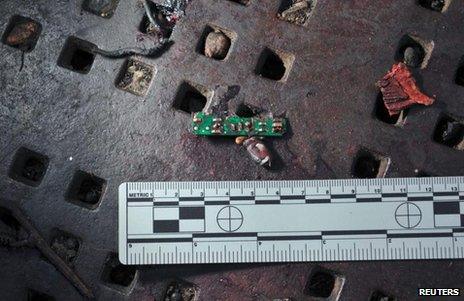
Investigators have released images taken of suspected bomb parts at the scene
Authorities in Boston are looking for those who are behind the bombings. And people from around the world are monitoring their progress.
Do not walk too closely to sports utility vehicles parked near Copley Square Hotel on Huntington Avenue. If you do, a dog will lunge, at least from inside a vehicle marked "CAUTION POLICE DOG".
He is held back by thick mesh that covers a window, but his snarl is loud - and menacing.
The dog is part of a K9 unit that is helping with the investigation into the explosions - "the most complex crime scene that we've dealt with in the history of our department," said Ed Davis, a police commissioner for the city of Boston.
He was speaking to a group of journalists who had gathered on Tuesday morning at the Westin hotel. All of them had questions, but there were few answers.
Clues from chaos
Outside, the crime scene looks huge. It is roughly 12 city blocks, according to Mr Davis. Still, it is smaller than before. A day earlier, it was 15 blocks.
The investigators are narrowing their search for evidence.
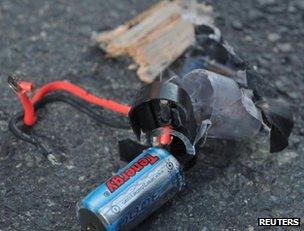
The remains of what appeared to be a triggering mechanism were found
Homeland Security Secretary Janet Napolitano told members of the House Homeland Security Committee that the FBI wants to talk to two men about the bombings.
Investigators have photos of two male suspects, according to media reports, but they have not revealed details about them or released the pictures.
At first, the authorities were looking for bombs. Now they say there were only two - and they are no longer concerned that there are more.
They have released images that appear to show the remains of a dark-coloured backpack and a pressure cooker, as well as a triggering mechanism.
A source close to the investigation said the bombs consisted of explosives placed in 1.6-gallon pressure cookers, one with shards of metal and ball bearings, the other with nails. The bombs were placed in black bags and left on the ground, the source told AP news agency.
The authorities are now looking for anything that might have been part of the explosive devices - bits of metal or sharp objects that they might be able to trace back to its owner or owners.
They have found scraps of black nylon near the site of the explosion.
The lid of a pressure cooker has been found on the roof of a building on Boylston Streets. Security guards are keeping people away from the street, and shops have been closed.
The discovery of the lid is an important step in the investigation.
"It might have fingerprints," Juliette Kayyem, the former Massachusetts homeland security adviser, told CNN.
"It is a big clue."
Images from the bombing site on the day of the marathon may also provide clues. "This was probably one of the most well-photographed areas in the country," Mr Davis said at the news conference.
People took pictures and footage of their friends and family members as they completed the race. Such a highly photographed, media-friendly area could make the site a popular pick for a bomber looking to make a public impact. But the countless photos can also provide crucial clues to investigators.
Pressure cooker bombs
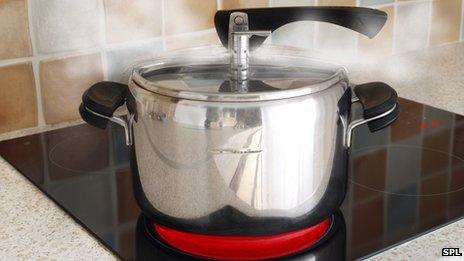
Pressure cookers are cheap and easy to buy. Details of a pressure cooker bomb were once published in an online al-Qaeda magazine. It was one of three devices used in the 2010 attempted attack on Times Square in New York.

The US Dept of Homeland Security has issued two previous warnings about the dangers of pressure cooker bombs. The cooker is a tightly-sealed pot, which can increase the force of the blast when packed with explosives.
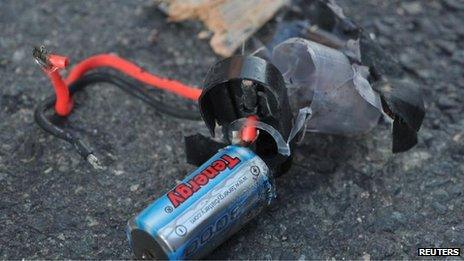
The explosion can be triggered using a simple device like a digital watch or mobile phone. Immediately after the explosions in Boston, the mobile phone network was closed down as a security precaution.

The Boston explosions contained metal shards, nails and other types of shrapnel, designed to cause maximum injury. Many of those wounded in the Boston attack suffered lower leg injuries and shrapnel wounds.
During the 2011 Vancouver Riots, for instance, forensic scientists were able to tag criminal activity in crowd-sourced videos and then track those suspects on tape, all while documenting identifying features and clothing.
Doctors say they have found ball bearings and nails in the bodies of those who were hurt, according to media accounts. These details are also helpful for the investigators.
Investigators can use the material - and even information about them - to put together a more complete picture of the explosive devices and how they were made. At that point, the investigators might be able to find out where the material was purchased - and who bought it.
Rebuilding the attack
They are trying to navigate unfamiliar territory.
"We know 9/11, but what do we know since 9/11 that we would define as a terrorist attack?" says Karen Greenberg, director of Fordham Law School's Center on National Security. "This is a different thing."
Since 9/11, there have been close calls, but nothing like what happened in Boston. In New York in 2010, for example, a man named Faisal Shahzad tried to set off explosives in Times Square but failed.
Nevertheless, some aspects of the investigation are familiar. The authorities are examining the explosive device. "You try to look for fingerprints," says Marc Sageman, author of Understanding Terror Networks.
The investigators will also "reverse-engineer" everything, says a former military officer who once specialised in bombings in combat zones.
In this way, the investigators will try to understand the mechanics of the attack.
The former officer, who asks not to be identified, says he has been under-whelmed by the tradecraft of the Boston bomb-makers. They bungled the job, he says - and had only minimal impact.
"It's tragic and horrible, but from a strategic point of view it just shows that they're idiots," he says.
"It was just crappy planning from the get go," he says.
The fact that the bomb killed three people in a crowded area of Boston offers some information about the planning, experience and ability of those who planted it.
If the bombers had been more sophisticated in their approach, they could have killed many more. In this way, the culprits inflicted a smaller amount of damage than they might have if they had been more efficient in their bomb-making and delivery.
Luck needed
Despite all the hi-tech advances since 9/11 and earlier bombings, like the Oklahoma City bombing in 1995 and the Olympic Village bombing in 1996, the biggest breaks may come from good old-fashioned human error.
Mr Sageman says many militants make mistakes.
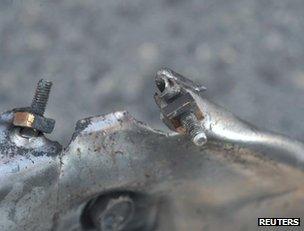
It appears pressure cookers were used for the bombs in Boston
"People are not always that careful," he says, referring to the perpetrators of these crimes.
After the World Trade Center bombing in 1993, for example, investigators found a car registration number on the axle of a vehicle. That led law enforcement to a car rental shop in New Jersey, where the bomber later returned.
"The guy who rented the car went back and wanted his money back," says Mr Sageman. "A moron."
In this way, investigations get lucky. "Most of the time they make mistakes," says Mr Sageman, referring again to the terrorists. "Or people brag."
The key to an investigation, he says, is not to make assumptions about what will be found.
"You have to allow the investigation to unfold and to go in there without a prejudiced view," he says.
Meanwhile, the police and their dogs are trying to keep the crime scene clear. At the Marriott hotel on Huntington Avenue, two members of a SWAT team walk through a Starbucks.
Wearing helmets and desert boots, they are heavily armed - and seem better suited for Afghanistan's Helmand province than downtown Boston.
Until there are more answers, this is part of the new normal.